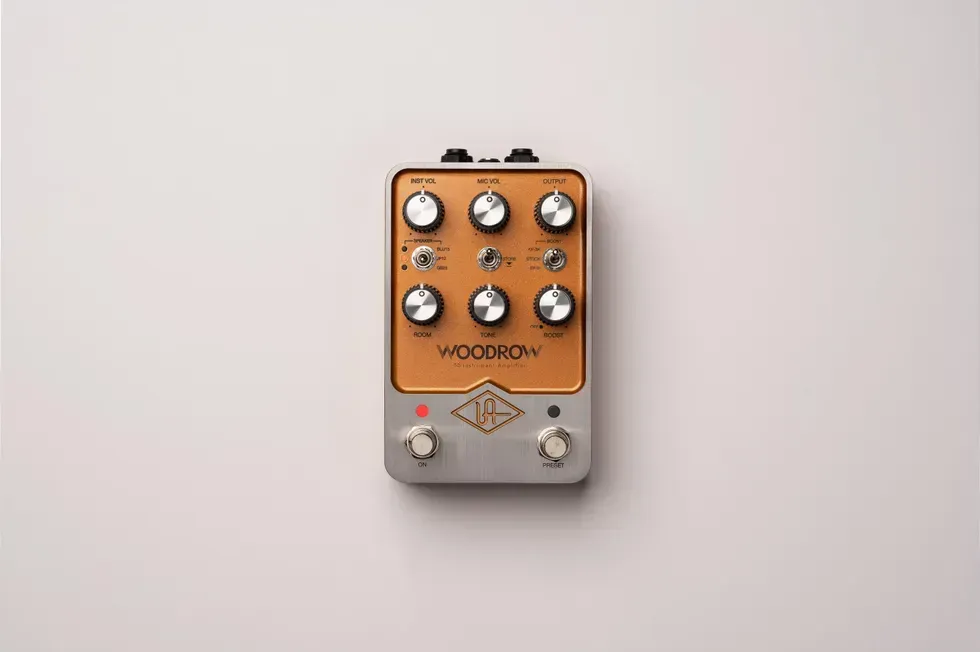If you need to jack into the essence of a classic amp, but don’t have a room full of vintage treasures, there are a lot of authentic digital roads to those destinations. But few are as fun, fast, or convenient as UAFX’s new amp emulation pedals. When I checked out the AC30-inspired Ruby not too long ago, I was surprised by how visceral, organic, and exciting the Ruby felt. The same can be said for the Woodrow ’55, UAFX’s 5E3 tweed Deluxe emulation reviewed here.
For unadulterated excitement, it’s hard to beat a real 5E3 Deluxe. The combination of lively cleans (at least at lower volume), saturation, squish, and a hot, sometimes downright explosive side makes the 1955 to 1960 Deluxe one of the sweetest and nastiest 15 watts in amplifier history. The fact that the Woodrow wrings so much of the 5E3’s tactile sensations and sensitivity from digital origins is impressive. That it captures so many of the unexpected treats that come from the 5E3’s famously, sometimes mysteriously, interactive tone and volume controls is a bonus, too.
Primal Pine Sensations
Relative to some of its UAFX amp emulation siblings, the Woodrow, like it’s 5E3 inspiration, can seem austere. Where the Ruby and the black-panel-Deluxe-inspired Dream feature rich reverb and tremolo emulations, the Woodrow, true to spec, is without either. Instead, you get a boost control with options for Echoplex EP-3 or Korg SDD-3000 preamp simulations or a more transparent boost. Like the other pedals in this series, the Woodrow also has switchable speaker emulations. Here, they include Celestion Greenback- and Celestion Blue-style speakers, which add a touch more headroom and midrange throatiness, and the raspier, more vintage-correct, and arguably more thrilling Jensen P12R simulation. These speaker settings are critical to setting the scene and extracting the most authentic tweed-like sounds—especially if you pair the Woodrow with a tube amp at lower volume. Using the UAFX Control App, you can switch these emulations out for three cabinet simulations, including a Bassman 4x10, a Marshall 4x12, and a Fender 1x12 with a JBL. The latter two, in particular, are a gas.
Like the Ruby and Dream, the Woodrow has a master output that’s useful for sourcing properly aggressive Deluxe textures at lower volume. But it’s interesting to experiment with how you can combine the Deluxe tones with a little extra push from the output to fashion extra-complex drive sounds. Because a 5E3 has a single tone control—and because the tone control’s functionality is integral to shaping 5E3-style tones in an authentic way—the Woodrow, too, utilizes a single tone knob, where the Ruby and Dream have treble and bass controls. That leaves room for UA to include a room ambience control borrowed from the company’s OX cabinet emulator. And the extra atmosphere is often a great fit and subtle softening agent for the most compressed and spiky output from the pedal.
Deeper Connections
A lot of players will be perfectly content to use the Woodrow in front of an amp and leave it at that, but the Woodrow’s connectivity options open up scads of opportunities. For starters, you can bypass your amp’s preamp section via an effects loop (if your amp has one). You can route direct to a PA or cabinet. And, of course, Woodrow can be plugged directly into your DAW. These tones, too, are pretty impressive—particularly if you download one of the more adventurous cabinet emulations. In a mix, I doubt you’d hear too much lacking in the Woodrow’s approximations of 5E3 magic. And, at times, I’m sure I would relish the extra flexibility the Woodrow imparts to tracking via that process. Even so, it’s hard to get past how alive the Woodrow sounded in a room through any of a number of tube amps. Given my druthers, I’d take the Woodrow this way. But the option to go direct with such compelling results is worth a great deal.
The Verdict
The Woodrow ’55 feels more like an amp than a drive pedal, which is how most lesser, analog amp-in-a-box pedals feel at the end of the day. It’s not inexpensive. This is a high-quality pedal with a lot of research and development behind it. But if you thirst for the sonic sensations, thrills, and expressiveness of a tweed Deluxe and are reticent to pay the price in dollars or space, the Woodrow’s ability to span the expanse between a pedal solution that comes up short and the real deal makes the price look, in practical terms, like a real bargain.





















